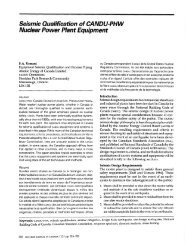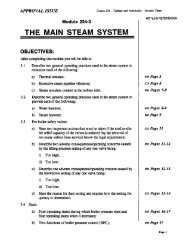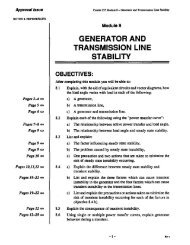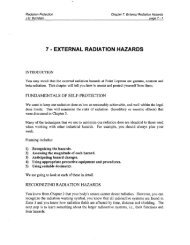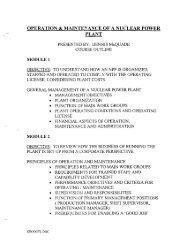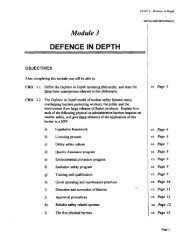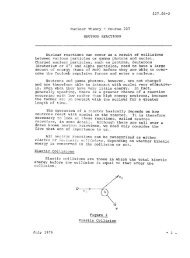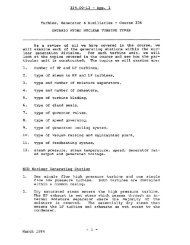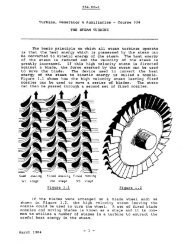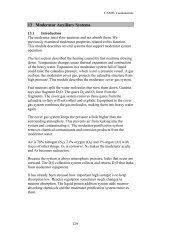Reactor Control Systems of Qinshan Phase III CANDU ... - canteach
Reactor Control Systems of Qinshan Phase III CANDU ... - canteach
Reactor Control Systems of Qinshan Phase III CANDU ... - canteach
You also want an ePaper? Increase the reach of your titles
YUMPU automatically turns print PDFs into web optimized ePapers that Google loves.
These different kinds <strong>of</strong> reactivity control devices are provided for diversity such that<br />
failure <strong>of</strong> one set can be overcome by negative reactivity from another set.<br />
The primary method <strong>of</strong> short term reactivity control is by varying the levels in the 14<br />
liquid zone control absorbers. Normally, adjusters are fully inserted, mechanical control<br />
absorbers are fully withdrawn and the average zone level is between 20% and 70% full.<br />
The liquid zone control program converts the power errors into lift signals to the liquid<br />
zone control valves. The total lift signal to a given liquid zone control valve consists <strong>of</strong> a<br />
signal proportional to the effective power error plus a differential component<br />
proportional to the zone power error and zone level error at low power.<br />
A shortage <strong>of</strong> negative reactivity is indicated by high zone controller water level and/or a<br />
large positive power error. In this case the mechanical control absorbers are driven into<br />
the core in two banks. In the case <strong>of</strong> a shortage <strong>of</strong> positive reactivity, indicated by low<br />
zone controller water level or a large negative power error, adjusters are driven out in<br />
banks according to a fixed sequence.<br />
Adjusters and mechanical control absorbers are driven out at a speed based on power<br />
error. This reduces the shim reactivity rate at low power errors, and enables the zone<br />
controllers to <strong>of</strong>fset the inserted reactivity with minimum power disturbances.<br />
<strong>CANDU</strong> 6 Digital <strong>Control</strong> Centre<br />
The <strong>CANDU</strong> 6 <strong>Control</strong> Centre combines the well-established operations interface and<br />
control systems, proven through 70 reactor-years <strong>of</strong> operation, with advanced features<br />
developed and pro<strong>of</strong>-tested at AECL, to deliver a state <strong>of</strong> the art set <strong>of</strong> features and<br />
benefits.<br />
The <strong>CANDU</strong> 6 control centre design is founded on proven systems, components and<br />
technology and only incorporates improvements with proven features and systems. The<br />
control centre design maintains all the elements demonstrated to be successful in operating<br />
<strong>CANDU</strong> units. Additionally, improvements have been made and performance tested as<br />
an integrated whole in AECLs mockup at Sheridan Park and in various implemented<br />
applications in operating <strong>CANDU</strong> plants (Gentilly-2, Bruce B, Bruce A, Pickering A,<br />
Pickering B). An artists' impression <strong>of</strong> the latest generation Main <strong>Control</strong> Room is<br />
included in Figure 3.<br />
CJNPE_paper990401<br />
11/21/05<br />
10




